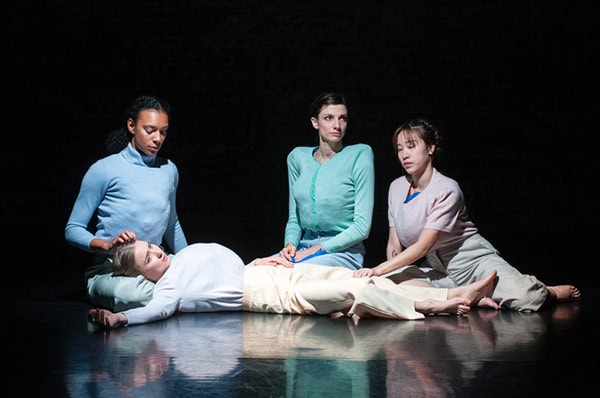Greta Gauhe and Alka Nauman at Chisenhale Dance Space
Posted: December 17th, 2019 | Author: Nicholas Minns | Filed under: Performance | Tags: Alka Nauman, Andy Trewren, Antonio Vivaldi, Ensemble Artaserse, Eva Recacha, Greta Gauhe, Keity Pook, Leilah Simone Williams, Lucie Palazot, Philippe Jaroussky, Shum Pui Yung | Comments Off on Greta Gauhe and Alka Nauman at Chisenhale Dance SpaceNOWhere & Be Fruitful and multiply at Chisenhale Dance Space, November 30

As the first of two works on this evening’s program of new choreography by Greta Gauhe and Alka Nauman at Chisenhale Dance Space, Gauhe’s NOWhere is a timely examination of ‘issues of racial and sexual discrimination and harassment.’ Gauhe has taken an autobiographical approach to structure the personal narratives of her dancers from four different countries on two continents, who express their stories through spoken word and dance. Dance theatre is the performative equivalent of mixed media or collage in the visual arts where one medium is juxtaposed with another so as to bring out a new meaning or metaphor in the whole. What Lloyd Newson’s verbatim theatre or Luca Silvestrini’s confessional theatre — not to mention Pina Bausch’s tanztheater — have all shown is how spoken word and dance can strengthen each other to create dramatic, sometimes surreal scenarios that express ideas physically, visually, intellectually and emotionally. In NOWhere, however, the notion of juxtaposition is replaced by a convergence between dance and spoken word that unfortunately blunts the impact of both; the stories don’t stand out as much as they should, and the dance is lost in trying to frame them. Through this subtle transfer of focus, even the sinister signification of the naked light bulbs at the beginning becomes an artful approach to lighting by the end. Between the ‘hostile environment’ of the current government and the #MeToo campaign, stories of racial or sexual discrimination and harassment need to be called out with a force that arouses our sense of outrage and empathy; resistance to the established order is one of art’s primary functions. In its urgent call for action in the present time and place, NOWhere needs a stronger emphasis on the stories at its heart; they are too often inaudible through a problem either of acoustics, of weak diction, or of voices having to compete with Andy Trewren’s electronic keyboard accompaniment.
It is difficult to know if Alka Nauman’s Be Fruitful and multiply is a polemic or a paean. Lying somewhere between the two, ‘the piece focuses on the ambiguous nature of plastic bags, on their elegance and ugliness…to reveal the absurdity of our attitude towards the environment.’ Nauman’s adoption of the absurd as a creative tool (it comes as no surprise that she cites the support of Eva Recacha) reveals its purpose in destabilising our response to the work, but the integrity of conception is such that this disruption is what makes it so effective. The stage is set with a tableau of four languidly posed women — Lucie Palazot, Keity Pook, Shum Pui Yung and Leilah Simone Williams — on one side in pastel t-shirts and pants and a pile of blue plastic bags on the other. Staring out over each other into the infinite distance, the four women inch their way in silence towards the pile with calculated reserve and control, creating bemused tension by maintaining the direction of movement while eliminating any sense of motive. When they reach the bags and start to explore their buoyant, pliant qualities in slow motion caress, the previous action is resolved but the future course of the work is once again in question. In Nauman’s absurdist construction, the negative environmental connotation of plastic bags loses its signification to one of aesthetics; the four women pose, balance and swing the bags like weightless jewellery on their arms and heads. They continue their reverie — with ever serene nonchalance — in padding their t-shirts with the bags, distorting their bodies to a bloated caricature, and later drawing them out as if by surgical procedure. By confounding reverence for the environment with devotion to one of its principal pollutants, Nauman satirizes our blindness to ecological destruction. The silence finally breaks with a recording of Antonio Vivaldi’s Sileant Zephyri that is itself a musical fragment mourning the death of Christ and its effect on nature. The four women, with their heads covered in plastic bags, are poised individually in a final tableau. As they each lip-synch the recitative (sung by counter tenor Philippe Jaroussky accompanied by Ensemble Artaserse), a sense of calm descends, with only Yung’s hands and fingers showing any vestige of life.
‘Let the winds be hushed,
let the fields freeze,
the flowers and leaves will not
be drenched with the water they love.
With the river dead
even the moon and the sun
will be deprived of their own light.’
(Translation from the Latin by Pietro Lignola)